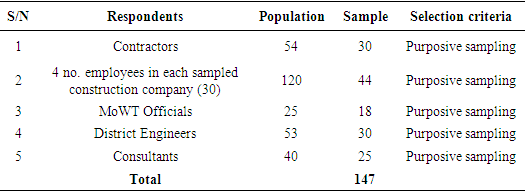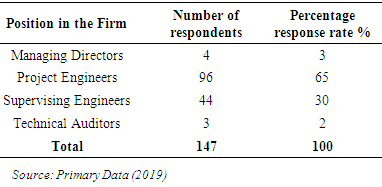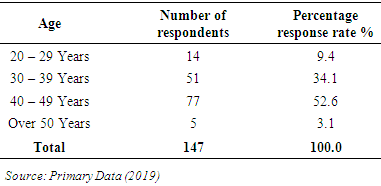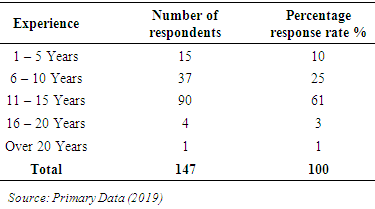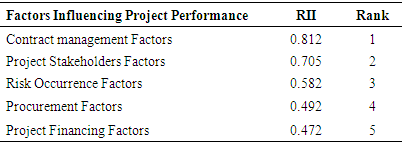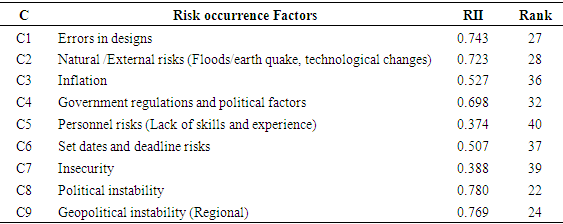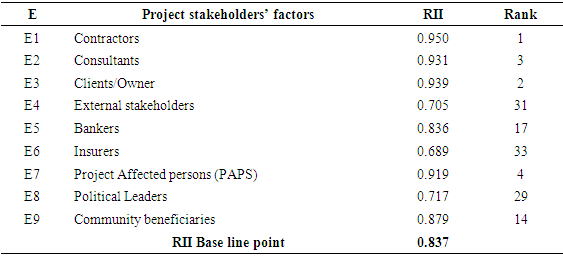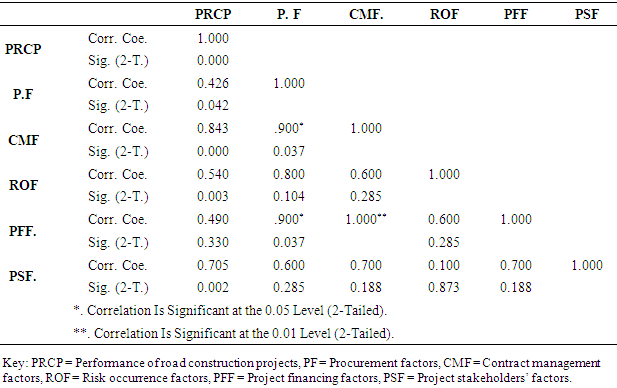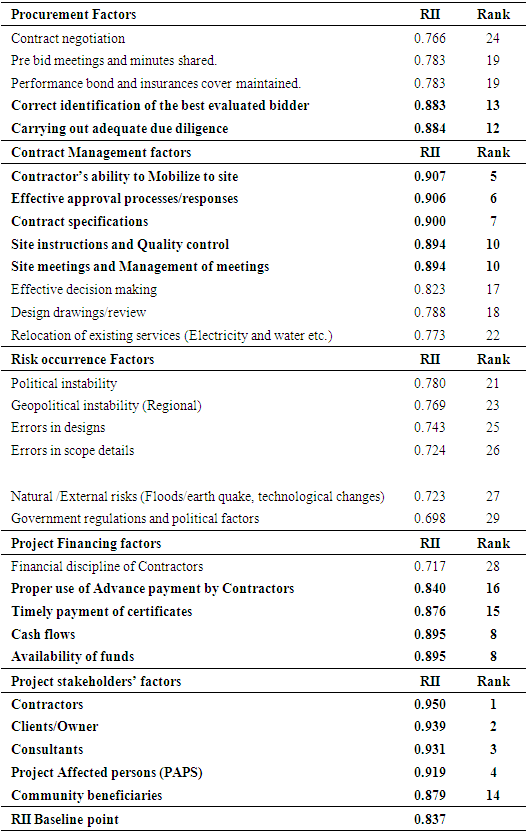-
Paper Information
- Paper Submission
-
Journal Information
- About This Journal
- Editorial Board
- Current Issue
- Archive
- Author Guidelines
- Contact Us
International Journal of Construction Engineering and Management
p-ISSN: 2326-1080 e-ISSN: 2326-1102
2021; 10(4): 101-115
doi:10.5923/j.ijcem.20211004.02
Received: Apr. 27, 2021; Accepted: Sep. 8, 2021; Published: Sep. 26, 2021

Assessment of the Factors Influencing Performance of Road Construction Projects in Uganda: A Case Study of Ministry of Works and Transport
S. Seninde, L. Muhwezi, J. Acai
Department of Civil and Environmental Engineering, Faculty of Engineering, Kyambogo University, Kampala, Uganda
Correspondence to: S. Seninde, Department of Civil and Environmental Engineering, Faculty of Engineering, Kyambogo University, Kampala, Uganda.
| Email: |  |
Copyright © 2021 The Author(s). Published by Scientific & Academic Publishing.
This work is licensed under the Creative Commons Attribution International License (CC BY).
http://creativecommons.org/licenses/by/4.0/

The road construction projects in Uganda suffer from many problems and complex issues in performance such as; cost, time, scope and quality. The aim of this study was to assess the factors influencing performance of road construction projects in Uganda. The study adopted a descriptive research design and data were collected using questionnaires from 147 purposively selected respondents from construction companies, consultancy firms, and government. Relevant literature was reviewed to establish actual factors influencing performance of road construction projects in Uganda. Data were coded and entered into statistical packages for social scientists (SPSS) version 25. Data were analyzed descriptively using statistical correlation and regression analysis, and Relative Importance Index (RII) was used to rank the identified factors. The research study revealed five most significant and influential factors on the performance of road construction projects in Uganda and these included; contractors, clients/owners, contractor’s ability to mobilize to site, availability of funds/ cash flows, and site instructions and quality control; and three least influential factors; inadequate mobilization of resources, inadequate geotechnical and hydrological studies, and lack of equipment. The study concluded that contract management, Project stake holders’ factors and project financing factors significantly influence the performance of road construction projects in Uganda.
Keywords: Assessment, Performance, Road construction projects, Relative importance index
Cite this paper: S. Seninde, L. Muhwezi, J. Acai, Assessment of the Factors Influencing Performance of Road Construction Projects in Uganda: A Case Study of Ministry of Works and Transport, International Journal of Construction Engineering and Management , Vol. 10 No. 4, 2021, pp. 101-115. doi: 10.5923/j.ijcem.20211004.02.
Article Outline
1. Introduction
- In the world over, construction industry is the sector involved with the erection, repairs, and demolition of buildings and civil engineering structures in the economy (Nyangwara et. al., 2015). Construction industry plays a major role in the development and achievement of the goals of a society. Generally, the construction works are increasing rapidly to meet the growing needs of the population and to keep up with the global development. Construction industry is complex in its nature as it involves a number of parties such as clients, contractors, consultants, stakeholders, shareholders, and regulators. These parties affect the performance of projects measured in terms of time, cost, quality, client satisfaction, productivity, and safety.There are various factors that affect construction projects performance which include: closures, modification of drawings and changes in designs, poor management and guidance, poor relations, and coordination, lack of motivation, control, monitor or decision-making systems, inadequate infrastructure, political problems, cultural problems, and economic conditions (Alias et. al., 2017).Odhiambo and Munturi, (2017) and Nwachukwu et al., (2010), termed that a road construction project is successfully completed if it passed four success test criteria namely: time; cost or funds; the effectiveness; and client’s satisfaction. However, in a Ugandan context, most construction projects are completed with significant cost, scope, and time deviations, a case of Kanoni – Sembabule – Villa maria (120KM) and Hima – Katunguru (58KM) roads construction projects were investigated due to implementation irregularities in the order of Ushs 322billion (US87.278Million) Mwelu et al., (2019). Most road construction projects are eventually completed more or less to specification, although they are seldom on time and within budget (Agaba & Shipman, 2017). Previous studies in Uganda show and prove that the failure of any project is mainly related to the problems and failure in performance (Alinaitwe, et al., 2013). There are many reasons and factors which attribute to such problems and appear through different directions such as; project procurement processes, project financing, risk occurrence factors and communication factors among others. Thus, if the key factors of influence that attribute to poor performance of road construction projects continue to be taken very lightly, government will remain to lose billions of shillings in failed or poorly executed road projects. Therefore, the purpose of this study was to assess the factors influencing the performance of road construction projects in Uganda. The specific objectives were: to establish the factors influencing the performance of road construction projects in Uganda; establish the extent of impact of the factors influencing performance of road construction projects in Uganda; determine the relationship between the factors influencing performance and the performance of road construction projects in Uganda; and develop a framework to improve the performance of road construction projects in Uganda. The output of this research is its contribution to the understanding of the factors influencing the performance of road construction projects in the road sector of the developing countries like Uganda. The result of the study is vital to other researchers who are involved in formulation of policies, and make contributions to literature with more data on the factors influencing performance of road construction projects in the construction industry.
2. Literature Review
2.1. Key Concepts of Project Performance
- Okuwoga (2014) stated that the performance of the construction industry is considered as the source of concern to both public and private sector clients. Karim and Morosszeyky (2009) studied performance measurement using key performance indicators (KPIs). KPIs include factors such as time, cost, quality, client satisfaction, client changes, business performance and safety in order to enable measurement of project and organizational performance throughout the construction industry.This information can then be used for benchmarking purposes, and will be a key component of any organization move towards achieving best practices (Duggan and Elisa, 2019). Kazi et al., (2012) defined performance measurement as monitoring and controlling of projects on a regular basis. Aziz & Hafez (2013) stated that project performance measurement means an improvement of cost, schedule, and quality for design and construction stages.
2.2. Problem of Performance in Construction Industry
- Ogunlana et. al., (2015) stated that the construction industry performance problems in developing economies can be classified in three layers: problems of shortages or inadequacies in industry infrastructure (mainly supply of resources), problems caused by clients and consultants and problems caused by contractor incompetence/inadequacies. Okuwoga, (2014) identified that the performance problem is related to poor budgetary and time control. Long et al., (2004) remarked that performance problems arise in large construction projects due to many reasons such as: incompetent designer/contractors, poor estimation and change management, social and technological issues, site related issues and improper techniques and tools.
2.3. Construction Management and Performance
- Management in construction industry is considered as one of the most important factors affecting performance of works. Brown and Adams (2000) studied a new approach to the measurement of the effect of Building Project Management (BPM) on time, cost and quality. Lehtonen (2001) developed a model for performance measurement which assist both firms’ top management and operational managers for continuous feedback on operational activities. Documenting and archiving performance data could be useful for future reference, such as for settling disputes on claims, maintenance and repair works (Thomas, Palaneeswaran and Kumaraswamy, 2002).
2.4. Information Technology and Construction Projects Performance
- Olanipekun et al., (2017) remarked that construction industry is considered as one of the industries using information technology techniques such as software management systems, database and communications. For many years, many processes, functions, operations were done with difficulty because of absence of IT field. In addition, most of the work was done manually which led to more cost, time and poor performance. Chan and Kumaraswamy, (2006) remarked that effective communication and fast information transfer between managers and participants help to accelerate the building construction process and performance. There are many benefits and relations of using IT in the construction projects such as: greater use of IT correlates with better project performance; owners and contractors realize meaningful benefits; IT affects schedule compression beneficially; and overall project cost savings which lead to a successful performance of projects (Schwegler et. al., 2016).
2.5. Factors Affecting Performance of Managers
- A study by Ogunlana et. al., (2015) recommended the need for focused effort by economy managers and construction industry associations to provide the infrastructure needed for efficient project management and performance. Dissanayaka and Kumaraswamy (2009) stated that the knowledge that would influence potential performance enables project managers to pay special attention to control performance more effectively.
2.6. Factors Affecting Cost and Time Performance
- Ugwu and Haupt, (2016) remarked that studies in various countries appear to have contributed significantly to the body of knowledge relating to time performance in construction projects over the past three decades, while Iyer and Jha (2005) remarked that project performance in terms of cost is studied since 1960s. Pheng and Chuan (2006) stated that there have been many past studies on project performance according to cost and time factors. Muizz et al., (2020) stated that; poor site management, unforeseen ground conditions and low speed of decision making involving all project teams are the three most significant factors causing delays and problems of time performance in local building works. Thus, the effects of delays may include time and cost overruns, litigation and project abandonment. Okuwoga, (2014) stated that cost and time performance has been identified as general problems in the construction industry worldwide.
2.7. Factors Affecting Road Construction Performance
- In the earlier study by Alinaitwe et al., 2013, a number of factors that are influenced by the clients and can affect the road construction performance were found to include: design changes, stoppage due to dispute between contractors and owners, stoppage because of insolvency, lack of adherence to regulatory requirements and inspection delays. Ogunlana et al., 2015 also cited a number of factors affecting road construction performance and these include: poor planning and poor management; Lack of experience; Inadequate controls during road construction; scarcity of road construction materials; Delayed commencement of works; delay to make decisions, and failure to address road safety. Other factors noted include: stakeholder’s lack of continual participation, attitude to service, excessive amendments of designs and drawings, ineffective monitoring and feedback, and lack of project leadership skills. Procurement systems, project team performance, conflict between the project parties, poor workmanship and external conditions lead to poor project performance. Project Managers’ ignorance and lack of knowledge; faulty project conceptualization; and aggressive competition during tendering also affect road construction performance.
3. Research Methodology
3.1. Research Design and Approach/Strategy
- According to Kothari (2004) research design is a plan, a road map and blue print strategy of investigations conceived so as to obtain answers to research questions. It is a procedural plan that is adopted by the researcher to answer research questions objectively, accurately and economically (Kumar, 1996). Research designs can be broadly classified into quantitative and qualitative research designs. This research study adopted descriptive research design since the researcher was interested in describing the case under study. It is a theory based research design created to gather, analyze and present data. There are three approaches that exist in research studies: qualitative, quantitative and the mixed methods (Amin, 2005). The mixed methods research approach is an approach to inquiry involving collecting both quantitative and qualitative data, integrating the two forms of data, and using distinct designs that may involve philosophical assumptions and theoretical frameworks (Muleya et. al., 2020). The core assumption of this form of inquiry is that the combination of qualitative and quantitative approaches provides a more complete understanding of a research problem than either approach alone. Thus, the research study employed the mixed methods approach to attain research objectives.
3.2. Study Population
- The study population included fifty-four (54) contractors and forty (40) consultants – all private companies/firms were contracted by the Ministry of Works and Transport (MoWT) and twenty-five (25) MoWT officials and 53 District Engineers. The key respondents that informed this research included thirty (30) Contractors (managers), forty-four senior employees from the sampled contractors/construction companies, eighteen (18) MoWT officials, thirty (30) District Engineers and twenty-five (25) consultants. The criteria for selection of each category of respondents is presented in Table 1.
|
3.3. Sample Size
- A sample is a finite part of a statistical population whose properties are studied to gain information about the whole population. Amin (2005) emphasized that a researcher must determine the sample size that will provide sufficient data to answer the research problem. The sample size was calculated using equation (1), in order to achieve 95% confidence level (Assaf et. al., 2001and Moore et. al., 2003).
 | (1) |
3.4. Area of Study
- This study was conducted in the Ministry of Works and Transport on the District roads which were rehabilitated by contracting private contractors, consultants and supervised by engineering staff within the Ministry of Works and Transport, and the District Engineers. The emphasis was on District road rehabilitation/District road construction projects undertaken within 10 years between 2008 and 2017. This study did not include national roads under the Uganda National Roads Authority (UNRA) and therefore UNRA was not involved and had no role to play in the research.
3.5. Data Collection Methods
- Both primary and secondary data were used in this study. According to Kothari (2011), primary data are those which are collected for the first time and thus happen to be original. The primary data were collected using a semi-structured questionnaire. Mwakajo and Kidombo (2017) indicated that questionnaire is a popular method of collecting data because researchers can gather information fairly easily and the questionnaire responses are easily coded. The data was collected using the drop and pick later method. Secondary data were collected using the document analysis method and the interview method.
3.6. Data Collection Instruments
- Primary data were collected using a combination of closed and open-ended questionnaire. The questionnaire was preferred because of its simplicity in administration and low cost in implementation. Secondary data were obtained from annual reports, MoWT data bases, and contract documents, project completion reports and progress reports of various projects in MoWT and the use of interview guide.
3.7. Validity of the Instruments
- Ndegwa (2013) defines validity as the degree to which the researcher has measured what he is set out to measure. Validity is the data quality testing technique that enables it to measure what it is supposed to measure (Chitkara, 2005). The methods used to validate the standard questionnaire are many and include: content validity and face validity: construct validity: factor analysis. The researcher used face validity and involved experts to qualify the items in the questionnaire and agreed that the test was a valid measure of the concept which was being measured just on the face of it. It was also evaluated whether each of the measuring items matched any given conceptual domain of concepts.
3.8. Reliability of the Instrument
- Reliability is a measure of degree to which a research instrument yields consistent results or data, the same way each time it is used under the same condition with the same subjects. To ensure the reliability, a pretest was done as a final study on 10% of the respondents. Data was coded and entered into the computer. Cronbach’s Alpha Reliability coefficients were generated using computer program to estimate the reliability of the questionnaire. The Cronbach’s alpha reliability coefficient of 0.7 and above is acceptable (Sekaran 2003). When Cronbach’s α is less than 0.3 it means the reliability is at low level; the data therefore not reliable and cannot be accepted. Since the alpha value is inflated by a large number of variables then there are no set interpretations to what is an acceptable alpha value. A rule of thumb that applies to most situations is:0.9 - 1.0 Excellent; 0.8 - 0.9 Good; 0.7 - 0.8 Acceptable; 0.6 - 0.7 Questionable; 0.5 - 0.6 Poor; 0.0 - 0.5 Unacceptable.Table 2 shows the values of Cronbach’s Alpha for each filled section of the questionnaire and the entire questionnaire. For the filled sections, values of Cronbach’s Alpha were in the range from 0.752 and 0.901. This range is considered high; the result ensures the reliability of each filled section of the questionnaire. The Cronbach’s Alpha obtained was 0.814 for the entire questionnaire indicating an excellent reliability of the questionnaire and therefore used to collect data that was reliable and yielded dependable results.
|
3.9. Data Analysis
- Analysis of data included sorting, cleaning and organizing data from the questionnaires. The information was coded and entered into a spreadsheet and analyzed using Statistical Packages for Social Sciences (SPSS) Version 25 and was also analyzed using correlations and regression analysis. The main quantitative techniques included descriptive statistics such as absolute and relative (percentages) frequencies.Quantitative data was presented in tables and explanation presented in prose. Qualitative data was analyzed basing on the content matter of the responses. Responses with common themes or patterns were grouped together into coherent categories.
3.10. Attainment of Research Objectives
3.10.1. Establishing the Factors Influencing the Performance of Road Construction Projects
- Literature review on the performance of road construction projects was conducted through reading the different journal papers, books, reports, and other important documents found existing in the road construction sector to establish the factors influencing the performance of road construction projects. In addition, these factors were further validated through interviews of the different local experts in the area of study. The factors considered in the questionnaire were summarized and categorized according to previous studies and other factors were added as recommended by local experts. The relative importance index (RII) values of the different factors under study were determined and their averages computed. The relative importance index was computed as suggested by (Cheung et. al., 2004; Iyer and Jha, 2005; Ugwu and Haupt, 2007), using equation 2.
 | (2) |
3.10.2. Establishing the Extent of Impact of the Factors on Performance of Road Construction Projects
- The extent of impact of the various identified factors influencing the performance of road construction projects were categorized as low or high impact, using a Likert scale, where integers ascending or descending from 1 to 5 were used for rating. The likert scale is a psychometric response scale in which respondents specified their level of agreement to a statement typically in five points: (1) Strongly Disagree; (2) Disagree; (3) neither agree nor Disagree; (4) Agree; (5) Strongly Agree. The relative importance index (RII) was used for ranking the various factors. The average of the RII for the various factors was computed and used as a baseline point, above which they were considered as the significant factors having the most impact on the performance of road construction projects.
3.10.3. Establishing the Relationship between the Factors Influencing Performance and the Performance of Road Construction Projects
- The degree of agreement between respondents regarding the factors influencing the performance of road construction projects in Uganda was calculated giving frequencies and their percentages. Correlation analysis was conducted using Spearman’s rank correlation methods for all the factors. This was done using SPSS and the computations are presented in section four of this paper. The relationships of factors influencing performance and the performance of road construction projects were determined according to spearman’s correlation using equation (3).
 | (3) |
 | (4) |
3.10.4. Developing a Frame Work to Improve Performance of Road Construction Projects
- To accomplish specific objective four, firstly the factors above the RII baseline point having high extent of impact on the performance of road construction were obtained from the results in specific objective two. Furthermore, an average RII for all sub-factors of the different group factors was computed to determine the baseline point, above which the factors were considered significant and below which the factors were considered insignificant to be employed to develop the framework to improve performance of road construction projects.The relative importance index (RII) was also used to establish the most significant factors that were included in a framework to improve the performance of road construction projects. In this research, Likert scales (ordinal scales) as shown in Table 3 were used in specific objectives; one, two and three for ranking or rating data.
|
4. Findings and Discussions
4.1. Demographics of the Respondents
- In table 4, majority of respondents were project engineers (65%) followed by supervising engineers (30%), managing directors (3%) and technical auditors (2%). This implies that data collected were reliable since majority of the respondents were involved directly in road construction projects. In table 5, majority of respondents (53%) had age bracket of 40-49 years, followed by the age bracket of 30-39 (35%), then 20-29 years (9%) and lastly 50 years and above (3%). This implies that majority 88% of the respondents were between 30 and 49 years of age who had worked on various projects. In table 6, majority of respondents (61%) had experience between 11 to 15 years, followed by those between 6 to 10 years (25%), less than 5 years (10%), between 16 to 20 years (3%) and finally above 21 years with 1%. This implies that 86% of the respondents had experiences of between 6 to 15 years. Table 7, majority of the respondents were graduates (65%), followed by masters’ holders (30%), and diploma holders (5%). This implied, the majority 65% of the respondents had the required education to understand road construction projects and therefore provided reliable data.
|
|
|
|
4.2. Empirical Findings
4.2.1. Establishing Factors Influencing the Performance of Road Construction Projects in Uganda
- The factors influencing performance of road construction projects were established as five main factors: procurement factors; contract management factors; risk occurrence factors; project financing factors and project stakeholders’ factors. The sub factors totaling to 43 in number were established.According to the methodology, relative importance index (RII) was used to determine the most significant factors influencing performance of road construction projects as suggested by Cheung et al., (2004); Iyer and Jha, (2005) and Ugwu and Haupt, (2007).
4.2.2. Ranking of the Main Factors Influencing the Performance of Road Construction Projects
- From the analysis of the factors influencing performance of road construction projects, it was revealed that contract management factors influence the performance of road construction projects most in Uganda. The findings indicated that Contract Management factors was ranked highest RII (0.812), project stakeholders factors were ranked second RII (0.705), followed by Risk Occurrence factors with RII (0.582), Procurement Factors having RII of 0.492 and finally Project Financing factors with RII of 0.472. The table 8 gives the rankings of main factors influencing performance of road construction projects as established in this research. The finding agrees with a research by Long et al., (2004) who remarked that performance problems arise in large construction projects due to many reasons such as: incompetent designers and contractors, poor estimation and change management, social and technological issues, site related issues and improper techniques and tools as contract management issues which affect the performance of road construction projects. Another research conducted by Rowlinson and Lingard (2008) cited that project stakeholder as the most influential factor affecting the performance of road construction projects.
|
4.2.3. Extent of Impact of the Main Factors Influencing Performance of Road Construction Projects
- According to the analysis of the main factors, the study revealed that contract management factors have the greatest impact on performance of road construction projects since it was ranked highest with RII value of 0.993. This was followed by the Project stakeholders’ factors with second highest RII (0.886), the Risk Occurrence factors third highest RII (0.727), the Procurement Factor RII of 0.624 and finally Project financing factors fifth RII (0.581). This implies that for improvement in the performance of road construction projects, the contract management factors should be given more attention before other factors influencing performance of road construction projects and ranking presented in Table 9. The findings are compared to a research by Al-Momani (2000) who stated that the success of any project is related to two features; service quality in construction delivered by contractors and the project owner’s expectations.
|
4.2.4. Extent of Impact of the Sub-Factors of All the Main Factors Influencing the Performance of Road Construction Projects
- According to the analysis of the impact of all sub-factors of all the main factors influencing performance of road construction projects, it was revealed that contractors, the project stakeholders’ sub-factor had the highest impact in influencing performance of road construction projects, followed by Clients/Owners, the project stakeholders’ sub-factor. The rankings indicate the order from the highest to the least of the sub-factors influencing the performance of road construction projects, as presented from Table 10 to Table 14.
|
|
|
|
|
4.2.5. Most Influential and Impacting Factors on Performance of Road Construction Projects in Uganda
- From the analysis of the influence and extent of impact of the sub factors of all the main factors influencing performance of road construction projects, the study established ten most influential and impacting factors on the performance of road construction projects and the ten least influential and impacting factors on the performance of road construction projects in Uganda as presented in Tables 15 and 16 respectively.
|
4.2.6. Correlation Analysis of the Main Factors Influencing Performance of Road Construction Projects in Uganda
- Spearman’s correlation was used to determine the correlation and the level of significance of the different main factors influencing the performance of road construction projects and the analysis revealed high significant correlation between the various independent variables (the factors influencing performance of road construction projects) in table 16.
|
4.2.7. A Framework to Improve the Performance of Road Construction Projects in Uganda
- The relative importance index (RII) and rankings of extent of impact of factors influencing performance of road construction projects were computed. The average RII (baseline point) was used to determine the factors having the most and least significant extent of impacts on the performance of road construction projects as suggested by Cheung et al., (2004); iyer and Jha, (2005); Ugwu and Haupt, (2007).Further analysis of the sub-factors beyond the baseline points for each individual main factors; Contractors, Clients/Owner emerged the significant factors having the biggest extent of impact on the performance of road construction projects with RII of 0.950, followed by Clients/Owner with RII of 0.939, Consultants with RII of 0.931, Project Affected persons (PAPS) with RII of 0.919, Contractor’s ability to mobilize to site of 0.907, Effective approval processes/responses with RII value of 0.906, Contract specifications with RII value of 0.900, Cash flows of with RII value of 0.895, Availability of funds with RII value of 0.895, Site instructions and Quality control with RII value of 0.894, Site meetings and Management of meetings with RII value of 0.894, Carrying out adequate due diligence with RII value of 0.884, Correct identification of the best evaluated bidder with RII value of 0.883, Community beneficiaries with RII value of 0.879, Timely payment of certificates with RII value of 0.876, Proper use of Advance payment by Contractors with RII value of 0.840, presented in Table 17.
|
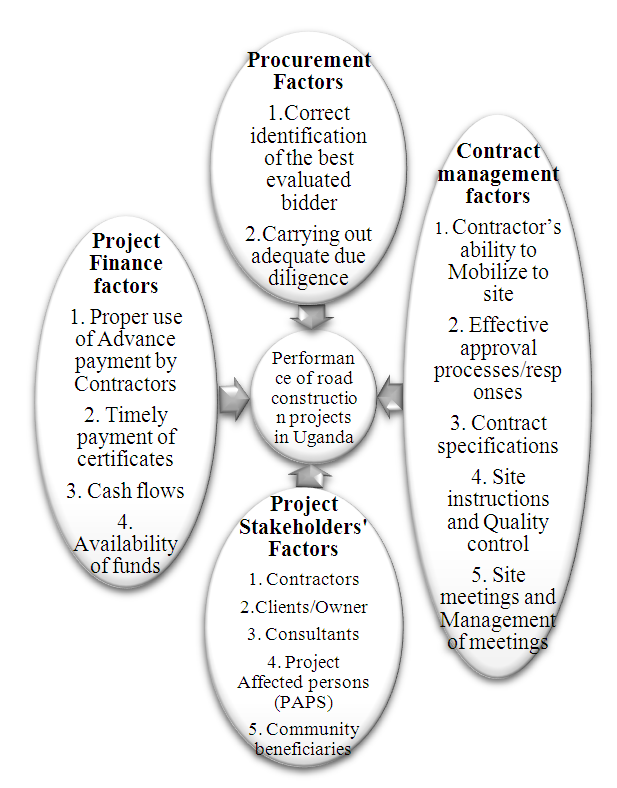 | Figure 1. Flow chart of the Framework to improve the performance of road construction projects in Uganda |
5. Conclusions and Recommendations
5.1. Conclusions
- This study assessed factors influencing performance of road construction projects in Uganda, with a case study of Ministry of Works and Transport. From the analysis of each objective, it was observed that among the five factor categories; contract management factors were ranked first in influencing the performance of road construction projects in Uganda, followed by project stakeholder’s factors, risk occurrence factors, procurement factors and lastly project financing factors. The factors influencing the performance of road construction projects in Uganda as established under five categories were further subdivided into 43 sub factors. The level of impact of the factors on performance of road construction projects was established; while the relationship between the factors influencing the performance and the performance of road construction projects in Uganda were also established.The research concluded that contract management significantly influenced the performance of road construction projects in Uganda. While a high correlation was observed between performance of road construction projects and the contract Management factors, Project stake holders’ factors and project financing factors. The research study further analyzed and observed that the performance sub factors with greatest impact and significant influence on performance of road construction projects in Uganda were; Contractors and clients /owners; carrying out adequate due diligence and correct identification of best evaluated bidder; contractors ability to mobilize to site; availability of funds and financial discipline of contractors; cash flows; and whereas the political and geopolitical instability negatively influence the performance of road construction projects in Uganda. Therefore, the objectives of this study were substantially accomplished.
5.2. Recommendations
- In this research study it is concluded that there exists a strong positive linear relationship between independent factors (procurement factors, contract management factors, risk occurrence factors, project financing factors, and project stakeholders’ factors) and the performance of road construction projects in Uganda. It is also concluded that the strong positive linear relationship of the performance of road construction projects is more with; the contract management factors, followed by project stakeholders’ factors, risk occurrence factors, project financing factors, and the procurement factors. Based on the above conclusions the following recommendations were made;§ Procurement processes should be ensured fair, transparent, and free of malpractices such as; corruption, nepotism and favoritism. § Contract management factors such as; contractor’s ability to mobilize to site, effective approval processes, contract specifications, site instructions and quality control, site meetings and management of meetings and minutes should be error free. Competent supervision team should also be employed so that during brain storming and meetings issues are addressed on time, hence avoiding delays.§ Risk occurrence factors can be avoided by following the standards using a lot of controls, employing skilled and competent laborers to avoid errors in designs and variations. For complex project conditions and unforeseeable natural disasters, a contingence fund of 10% should be included in the bills of quantities. For risk such as inflation include a clause to allow use of the prevailing commercial bank inflation rates to take care of changes in the prices of material. Changes in technology can be addressed by reserving a contingency fund in the bills of quantities for training employees on how to use the new technology.§ To ensure proper performance of road construction projects enough finances should be set aside for the project before it can commence. § The project stakeholders and clients should ensure that they support the ruling party or government and/or that be in good terms with the financier so that politics does not negatively influence performance of road construction projects.
6. Limitations of the Research
- Though best efforts were put in this research and findings do make a significant contribution for industry, this research had some limitations. First the sample size of 147 is considered to be on the smaller side for statistical analysis. Secondly, the respondents are not evenly distributed among the professional roles which may have induced some bias in the responses. Thus the framework developed may be further honed/refined based on detailed discussions and suggestions from industry experts. The relationship between various factors influencing performance and its impact on the overall project performance has to be detailed further which is the author’s recommendation for future research.
ACKNOWLEDGEMENTS
- I acknowledge with sincere thanks, my supervisors; Eng. Dr. Lawrence Muhwezi and Mr. Joseph Acai, for their invaluable guidance. To the University of Kyambogo I am grateful for providing me the opportunity to fulfill my personal goal of pursuing further studies in the area that is important to me in terms of career development.
Appendix A
- Questionnaire
 Master of Science program in construction Technology and ManagementAssessment of Factors Influencing Performance of Road Construction Projects in Uganda: A Case Study of Ministry of Works and TransportI am Seninde Stephen, a student of Master of Science in Construction Technology and Management at KYU, conducting a research study titled ‘‘assessment of factors influencing performance of road construction projects in Uganda’’. You have been identified as a respondent in this research study; and this questionnaire is required to be filled with exact relevant facts as much as possible. All the data included in this questionnaire will be used only for academic research. After all questionnaires are collected and assessed, interested participants of this study will be given feedback on the overall research results.Yours faithfully; ……………………………Part (1): General Information: Please add (√) as appropriate:1. GenderMale ( ) Female( )2. Position in the Firm;Managing Director ( ), Project Engineer ( ), Supervising Engineer ( ), Technical auditor ( ), If other, specify ……. 3. In which organization do you work? Government Ministry ( ) Consultancy Firm ( ) Contractor ( ) If others, specify …………..4. Which one best describes your age bracket?20 –29 years ( ), 30 –39 years ( ), 40 – 49 years ( ), over 50 years ( )5. How long have you been involved in the road construction projects?Less than 5 years ( ), between 6 –10 years ( ), between 11 –15 years ( ), between 16 –20 years ( ), above 20 years ( )6. Indicate the level of your education?Diploma ( ), Bachelor’s degree ( ), Masters ( ), PHD ( ), If others specify ……. Part (2): Factors influencing the performance of road construction projects:Below are a number of factors influencing the performance of road construction projects? From your experience and using the Likert scale of 1 to 5, please express your opinion on the importance of the following factors that positively influence performance of road construction projects in Uganda. (Please tick the appropriate box).5 = Very High importance, 4 = High importance, 3 = Medium importance, 2 = Low importance, 1= Very low importance.
Master of Science program in construction Technology and ManagementAssessment of Factors Influencing Performance of Road Construction Projects in Uganda: A Case Study of Ministry of Works and TransportI am Seninde Stephen, a student of Master of Science in Construction Technology and Management at KYU, conducting a research study titled ‘‘assessment of factors influencing performance of road construction projects in Uganda’’. You have been identified as a respondent in this research study; and this questionnaire is required to be filled with exact relevant facts as much as possible. All the data included in this questionnaire will be used only for academic research. After all questionnaires are collected and assessed, interested participants of this study will be given feedback on the overall research results.Yours faithfully; ……………………………Part (1): General Information: Please add (√) as appropriate:1. GenderMale ( ) Female( )2. Position in the Firm;Managing Director ( ), Project Engineer ( ), Supervising Engineer ( ), Technical auditor ( ), If other, specify ……. 3. In which organization do you work? Government Ministry ( ) Consultancy Firm ( ) Contractor ( ) If others, specify …………..4. Which one best describes your age bracket?20 –29 years ( ), 30 –39 years ( ), 40 – 49 years ( ), over 50 years ( )5. How long have you been involved in the road construction projects?Less than 5 years ( ), between 6 –10 years ( ), between 11 –15 years ( ), between 16 –20 years ( ), above 20 years ( )6. Indicate the level of your education?Diploma ( ), Bachelor’s degree ( ), Masters ( ), PHD ( ), If others specify ……. Part (2): Factors influencing the performance of road construction projects:Below are a number of factors influencing the performance of road construction projects? From your experience and using the Likert scale of 1 to 5, please express your opinion on the importance of the following factors that positively influence performance of road construction projects in Uganda. (Please tick the appropriate box).5 = Very High importance, 4 = High importance, 3 = Medium importance, 2 = Low importance, 1= Very low importance. Part 3: Extent of impact of the factors that influence the performance of road construction projects:i) Procurement FactorsClearly state your opinion with regard to the implementation of road construction projects by the Ministry of Works and transport. Do you think that the procurement processes and practices influence the performance of road construction projects? Yes ( ) NO ( ) Not Sure ( ).Using the scale of 1 to 5, rate the extent to which the following procurement factors have influenced the performance of road construction projects in Uganda: 1= Very little Extent; 2 = Little Extent; 3 = Fair Extent; 4 = Great Extent; 5 = Very Great Extent
Part 3: Extent of impact of the factors that influence the performance of road construction projects:i) Procurement FactorsClearly state your opinion with regard to the implementation of road construction projects by the Ministry of Works and transport. Do you think that the procurement processes and practices influence the performance of road construction projects? Yes ( ) NO ( ) Not Sure ( ).Using the scale of 1 to 5, rate the extent to which the following procurement factors have influenced the performance of road construction projects in Uganda: 1= Very little Extent; 2 = Little Extent; 3 = Fair Extent; 4 = Great Extent; 5 = Very Great Extent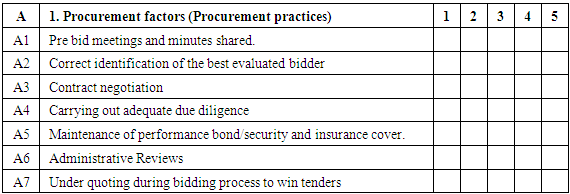 ii) Contract Administration/ Management Factors.Clearly state your opinion with regard to the implementation of road construction projects by the Ministry of Works and transport. Do you think that the Contract administration/management factors influence the performance of road construction projects? Yes ( ) NO ( ) Not Sure ( ).Using the scale of 1 to 5, rate the extent to which the following contract administration/management factors have influenced the performance of road construction projects in Uganda: 1 = Very little Extent; 2 = Little Extent; 3 = Fair Extent; 4 = Great Extent; 5 = Very Great Extent
ii) Contract Administration/ Management Factors.Clearly state your opinion with regard to the implementation of road construction projects by the Ministry of Works and transport. Do you think that the Contract administration/management factors influence the performance of road construction projects? Yes ( ) NO ( ) Not Sure ( ).Using the scale of 1 to 5, rate the extent to which the following contract administration/management factors have influenced the performance of road construction projects in Uganda: 1 = Very little Extent; 2 = Little Extent; 3 = Fair Extent; 4 = Great Extent; 5 = Very Great Extent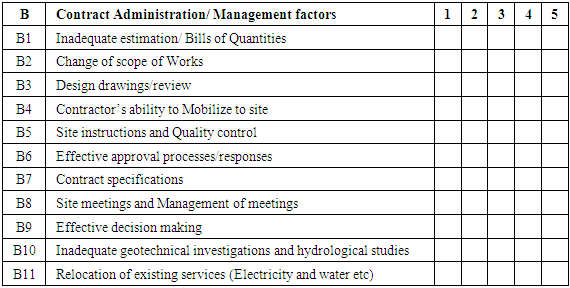 iii) Risk Occurrence FactorsClearly state your opinion with regard to the implementation of road projects by the Ministry of Works and transport. Do you think that the risk occurrence factors influence performance of road construction projects? Yes ( ) NO ( ) Not Sure ( ).Using the scale of 1 to 5, rate the extent to which the following risk occurrence factors have influenced the performance of road construction projects in Uganda: 1 = Very little Extent; 2 = Little Extent; 3 = Fair Extent; 4 = Great Extent; 5 = Very Great Extent
iii) Risk Occurrence FactorsClearly state your opinion with regard to the implementation of road projects by the Ministry of Works and transport. Do you think that the risk occurrence factors influence performance of road construction projects? Yes ( ) NO ( ) Not Sure ( ).Using the scale of 1 to 5, rate the extent to which the following risk occurrence factors have influenced the performance of road construction projects in Uganda: 1 = Very little Extent; 2 = Little Extent; 3 = Fair Extent; 4 = Great Extent; 5 = Very Great Extent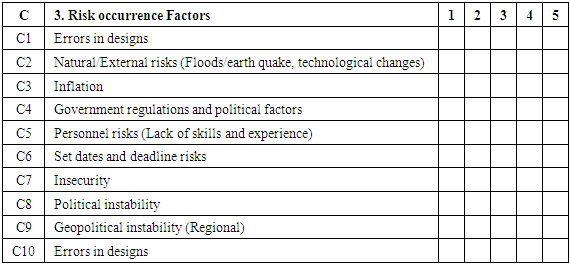 iv) Project Financing FactorsClearly state your opinion with regard to the implementation of road projects by the Ministry of Works and transport. Do you think that the Project financing factors influence performance of road construction projects? Yes ( ) NO ( ) Not Sure ( ).Using the scale of 1 to 5, rate the extent to which the following project financing factors have influenced the performance of road construction projects in Uganda: 1 = Very little Extent; 2 = Little Extent; 3 = Fair Extent; 4 = Great Extent; 5 = Very Great Extent
iv) Project Financing FactorsClearly state your opinion with regard to the implementation of road projects by the Ministry of Works and transport. Do you think that the Project financing factors influence performance of road construction projects? Yes ( ) NO ( ) Not Sure ( ).Using the scale of 1 to 5, rate the extent to which the following project financing factors have influenced the performance of road construction projects in Uganda: 1 = Very little Extent; 2 = Little Extent; 3 = Fair Extent; 4 = Great Extent; 5 = Very Great Extent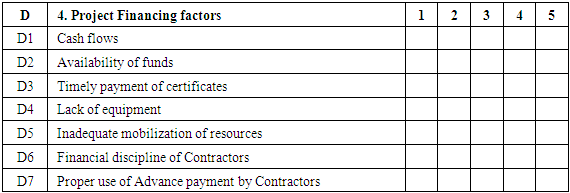 v) Project Stake Holders FactorsClearly state your opinion with regard to the implementation of road projects by the Ministry of Works and transport. Do you think that the Project stake holders’ factors influence the performance of road construction projects? Yes ( ) NO ( ) Not Sure ( ).Using the scale of 1 to 5, rate the extent to which the following project stakeholders’ factors have influenced the performance of road construction projects in Uganda: 1 = Very little Extent; 2 = Little Extent; 3 = Fair Extent; 4 = Great Extent; 5 = Very Great Extent
v) Project Stake Holders FactorsClearly state your opinion with regard to the implementation of road projects by the Ministry of Works and transport. Do you think that the Project stake holders’ factors influence the performance of road construction projects? Yes ( ) NO ( ) Not Sure ( ).Using the scale of 1 to 5, rate the extent to which the following project stakeholders’ factors have influenced the performance of road construction projects in Uganda: 1 = Very little Extent; 2 = Little Extent; 3 = Fair Extent; 4 = Great Extent; 5 = Very Great Extent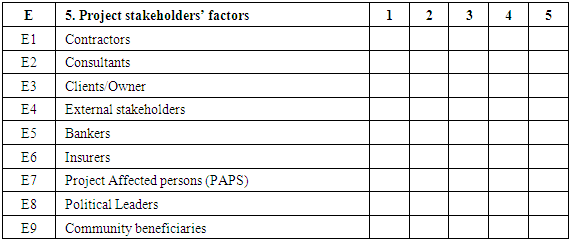 Part 4: Using your experience on the road construction projects, previously implemented under the Ministry of Works and Transport, indicate the major factors that influenced the performance of these road construction projects.
Part 4: Using your experience on the road construction projects, previously implemented under the Ministry of Works and Transport, indicate the major factors that influenced the performance of these road construction projects.
 Abstract
Abstract Reference
Reference Full-Text PDF
Full-Text PDF Full-text HTML
Full-text HTML